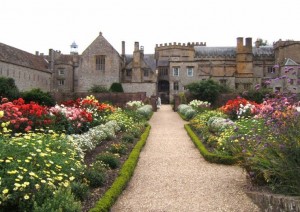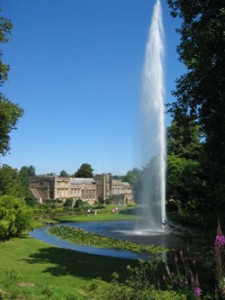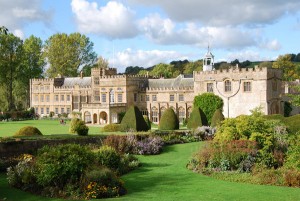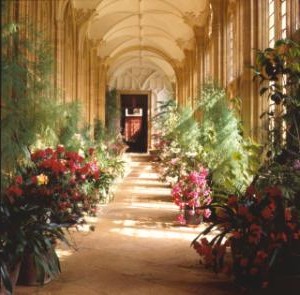In the peaceful solitude of its secluded position it is possible to imagine just how Forde Abbey, near Chard, along the Somerset/Dorset border, looked to many of its previous owners, from its mediaeval beginnings to the present day: monks going about their daily round of work and prayer, prosperous parliamentary gentlemen discussing the cavalier threat, gifted philosophers debating the imponderable, elegant Victorian ladies fanning themselves by the fireside and country gentlemen going about their work on the estate.
Foundation
In 1136 Richard de Brioniis founded a Cistercian monastery at Brightley in Devon. However, the land was too barren for an agricultural community, forcing the monks to return to Surrey in 1141. On their journey, they met their former patron’s sister and heir, Adelicia de Brioniis. Determined to honour the wish of her dead brother, she offered them the use of the Manor of Thorncombe and a site on the River Axe. They accepted and within seven years the monastery of Forde Abbey was built.
Forde Abbey flourished as a monastery for 400 years and became renowned as a seat of learning. The third abbot, Abbot Baldwin, became Archbishop of Canterbury before dying on the crusades. His successor, John Devonius, was confessor to King John, and reputably one of the most learned men of his time. It also became a wealthy foundation and by the 14th century owned some 30,000 acres. Each land transaction was recorded in the Cartulary which belongs to the Abbey to this day.
Dissolution
Abbot Chard, the last abbot, succeeded in 1521 and applied his substantial learning and imagination to a comprehensive restructuring of the fabric of the building. However, his work was interrupted in 1539 by the dissolution of the larger monasteries. Chard decided that discretion was the better part of valour and handed Forde Abbey quietly over to the Crown, becoming vicar of Thorncombe until his death in 1543. In the same year the Abbey and its lands was leased by the Crown to Richard Pollard for the sum of £49. 6s. 6d.
The Abbey gives a real sense of what was lost during this turbulent time in English history.
The Prideaux Legacy
For the next 100 years Forde Abbey was owned by a succession of absentee landlords with the building plundered for its stone. However, in 1649 it was purchased by Edmund Prideaux, Member of Parliament for Lyme Regis, fervent supporter of the parliamentary cause and, later, Oliver Cromwell’s Attorney General. He was largely responsible for transforming Forde
Abbey from a Monastic residence into a private home.
Prideaux died in 1659 and was succeeded by his son, also Edmund. Despite being considered an intelligent man he made the disastrous mistake of entertaining the Duke of Monmouth one night in 1680. Five years later, after the Battle of Sedgemoor in which James II’s army defeated Monmouth’s Protestant rebels, Prideaux was suspected of having supported the invasion. On the slender pretext of Monmouth’s earlier visit to Forde, he was arrested and imprisoned in the Tower of London on a charge of high treason. The notorious Judge Jefferies demanded a sum of £15,000 to save him from the gallows.
Edmund was ultimately pardoned and lived quietly at Forde until his death in 1702 when the estate was inherited by his daughter Margaret with her husband Francis Gwyn, later Secretary of War to Queen Anne. They and their descendants inhabited the Abbey throughout the 18th century making few changes to the house. To their eternal credit, however, they created the gardens.
Jeremy Bentham
A lack of money meant that John Fraunceis, last of the Gwyns, was unable to continue living in the Abbey. In 1815 he moved abroad and rented the Abbey to the radical philosopher, Jeremy Bentham. Bentham entertained a number of famous guests here, among them a young John Stuart Mill with his father James, the economist David Ricardo and legal reformer Sir Samuel Romilly. For a short time Forde Abbey played host to some of the greatest thinkers of the the early 19th century.
Victorian Forde Abbey
John Fraunceis Gwyn died without heirs in 1846 resulting in a massive sale of the Abbey’s contents. The house and lands were sold to a merchant called Miles, who apparently occupied just five rooms and allowed the rest to fall into disrepair. Forde was again sold in 1863 to Mrs Bertram Evans and so began another period of investment. Mrs Evans died in 1894, leaving the Abbey to her son William Herbert who, in turn, left it to his cousin Elizabeth, who was married to Freeman Roper. The Ropers moved into the Abbey in 1905.
Modern Forde Abbey and Gardens
In 1943 Elizabeth Roper died and the house passed in to the care of her second son, Geoffrey and his wife Diana. Geoffrey devoted his whole life to the Abbey and its gardens, living there for almost eighty years. He added the arboretum and planted many of the woods that are a feature of the estate.
The house is surrounded by 30 acres of spectacular award winning gardens. The landscape has developed slowly since monastic times. The monks certainly grew vegetables in large quantities, but whatever gardens they had have disappeared over the centuries.
The only monastic structure that remains today is the Great Pond at the top of the garden. This now brings water into the garden but originally its purpose was to power a mill for grain, which stood on the site of the present day Forge.
Sir Francis Gwyn created the beginnings of the garden that we see today during the early 18th century. Gwyn used the water to create the three lower ponds and the cascades that can be viewed from the centre of
the Border. He also planted the great Yews as part of his design, and probably the largest Limes.
The Centenary fountain celebrates 100 years of the Roper Family at Forde Abbey, and with a maximum height of 160 feet it is the highest powered fountain in England.
Link to Forde Abbey site: http://www.fordeabbey.co.uk/
Guide book: Forde Abbey and Gardens- 800 years of History
With thanks to Hannah and the staff team

